This July and August, we’re celebrating the release of Star Trek Beyond by taking a look back at the third season of the original Star Trek. Check back every Monday, Wednesday and Friday for the latest update.
Star Trek is dead.
Not in a literal or technical sense. The show had been brought back from the brink of cancellation, offered a last-minute reprieve by NBC following a number high-profile fan campaigns. As far as outside observers were concerned, Star Trek lived. Kirk and Spock would continue their voyages into the space, the production team offering new and exciting interstellar adventures for the delectation of the audience at home. The execution had been stayed, Star Trek was back on television for another season.

End of the line.
However, the show had been mortally wounded. Star Trek was clearly not a top priority for NBC. The show was moved to the infamous “graveyard slot” of Fridays at 10pm. The budget was slashed even further. Most of the top tier creative talent left, including veteran producers Dorothy Fontana and Gene L. Coon along with creator Gene Roddenberry. Tensions were simmering behind the scenes. Even before NBC cut the season order to twenty-four episodes later in the season, it was clear that the series was on its last legs.
Star Trek was very much in limbo. Indeed, looking at third season as a whole, many such analogies suggest themselves. Star Trek was a show limping and lurching towards its own funeral, hobbled and humbled by forced outside of its control. These creative problems bubbled through the production into the finished product, with much of the third season inheriting a haggard and defeated disposition. There is a funereal tone to a lot of the third season, distinct even from the Lovecraftian horror that bubbled through the show’s earliest episodes.

The brains of the operation…
Spectre of the Gun is part of that funereal tone, although it is also something different. Spectre of the Gun was the first episode of the season to be produced, although it was shuffled into the sixth broadcast slot. To be fair, this rescheduling seems appropriate; Spectre of the Gun aired both the week of Halloween and one day shy of the eighty-seventh anniversary of the gunfight at the O.K. Corral. The episode has a haunted quality to it, a more mournful horror than that on display in the franchise’s previous “Halloween episode”, Catspaw.
In some ways, there is an interesting contrast between the first episode of the third season to be produced and the first episode of the third season to air. Both Spectre of the Gun and Spock’s Brain speak to the grim realities of the third season, offering a taste of the anxieties simmering through the show. Both seem to acknowledge that Star Trek is a shell of its former self, whether in the half-remembered ghost town of Spectre of the Gun or the brainless Spock shuffling his way through Spock’s Brain. The only difference is that Spectre of the Gun is a good episode.

Men of mist-ery.
Death stalks through Spectre of the Gun. Seeking to confront the Melkotians, Kirk and his crew beam down to a formless world that is nothing more than swirling clouds of gas. When they find themselves transported to Tombstone, the sky is an ominous red and the Earps are cast as horsemen of the apocalypse. The world seems hollow; the sound stage is incomplete. Time ticks down, albeit to a fictional five o’clock deadline rather than the historical three o’clock shout out. During the final confrontation, the wind howls as if the world itself is screaming in anguish.
Spectre of the Gun confronts Kirk with a world of phantoms. It evokes a world long vanished into fading memory, populated by characters who died long before. It traps Kirk and his crew in what is effectively a death trap, cutting off all of their narrative options as it marches them inexorably towards a bloody finale. It is even written by a ghost, with Lee Cronin a convenient fiction allowing former producer Gene L. Coon the chance to write a few scripts for a show he had already departed and which was not long for this world. The setting is even called “Tombstone.”

Even the newspaper is in on it!
One of the more reliable indicators of behind-the-scenes turmoil involves significant turnover in the creative staff. Writers and producers tend to have a fairly good idea as to the general health of a show, and mass migration away from a series generally offers some indication that there is serious trouble brewing on the horizon. After all, it is easier for writers and producers to secure further job opportunities by departing a television show that is still running than it is to bounce back from a cancellation.
This is not always that case, of course. It is entirely possible for successful (and viable) television shows to experience significant overhauls and revisions in the creative team. Star Trek: The Next Generation, for example, underwent significant changes in the production team at the end of both the second and third seasons, but there was never any serious chance of the series being cancelled. However, there are plenty of counter examples. Star Trek: Enterprise faced a significant talent drain at the end of its third season, as writers and producers sought other opportunities.

Last chance saloon.
With the third season of Star Trek, there were a number of significant changes to the production team. Most obviously, Gene Roddenberry made a conscious effort to distance himself from his creation when it became clear that NBC were not going to schedule the show as to afford it a fighting chance at renewal:
I told NBC that if they would put us on the air as they were promising—on a weeknight at a decent time slot, 7:30 or 8 o’clock—I would commit myself to produce Star Trek for the third year. Personally produce the show as I had done at the beginning. About ten days or two weeks later, I received a phone call at breakfast, and the network executive said, “Hello, Gene, baby…” I knew I was in trouble right then. He said, “We have had a group of statistical experts researching your audience, and we don’t want you on a weeknight at an early time. We have picked the best youth spot that there is. All our research confirms this and it’s great for the kids and that time is 10 o’clock on Friday nights.” I said, “No doubt this is why you had the great kiddie show The Bell Telephone Hour on there last year.” As a result, the only gun I then had was to stand by my original commitment, that I would not personally produce the show unless they returned us to the weeknight time they promised.
It is hard to fault Roddenberry from wanting to step back from the production. After all, it is one thing to invest energy in a product that may fail; it is another to invest energy in something being set up to fail. Roddenberry had no energy left to arrange the deck chairs on the Titanic.

Pointing it out.
At the same time, there was something slightly cynical about Roddenberry’s detachment from the series. Roddenberry would remain credited as an “executive producer” on the show, continuing to draw a salary from a show that he knew to be under considerable financial pressure. More than that, Roddenberry would also try to exploit the show for his own ends. Perhaps the most egregious example of this would be his awkward attempts to shoehorn the IDIC medallion into Spock’s Brain and Is There in Truth no Beauty?, hoping to sell replicas via mail order.
Roddenberry was not the only major creative talent to take a step back from the show in its third year. John Meredyth Luca had overseen the production of the tail end of the second season, but was no longer as actively involved in the day-to-day operations; he would write and direct Elaan of Troyius, direct The Enterprise Incident and write the teleplay of That Which Survives. Dorothy Fontana opted not to continue as story editor, although she contributed the original draft of The Enterprise Incident and the stories for That Which Survives and The Way to Eden.

“The future does not look promising, Captain.”
Gene L. Coon had taken a job with Universal Television, working on the show It Takes a Thief. (As the title implies, it was inspired by the Alfred Hitchcock film To Catch a Thief.) However, Coon agreed to contribute a number of stories to the third season of Star Trek. As Robert Justman and Herb Solow outline in Inside Star Trek:
The Last Gunfight was one of the stories that [Gene Coon] was developing at the time he left Star Trek. But now, Coon was working elsewhere on an exclusive contract, and legally he could write only for Universal Television, his new employer. Intending to honor that contract, Coon explained that he would not be able to write the teleplay for Gunfight. Being a man of his word, however, Gene Coon arranged for Lee Cronin to complete the assignment. It was filmed and retitled Spectre of the Gun.
Indeed, Coon would also write Spock’s Brain, Wink of an Eye and Let That Be Your Last Battlefield under that pseudonym. Even after he had left the show, Coon still remained one of the writers with the strongest sense for iconic elements and memorable hooks. Although the quality of Spectre of the Gun, Spock’s Brain and Let That Be Your Last Battlefield might be wildly variable, they are certainly unforgettable.
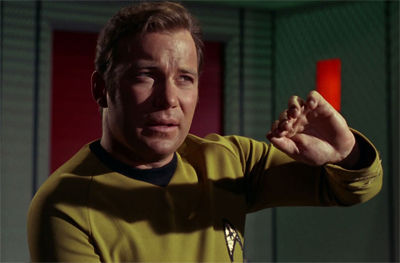
Kirk really wasn’t happy about the teaser to Spock’s Brain.
The very concept of Spectre of the Gun would be memorable on its own terms, even before delving into the show’s iconography and imagery. On a mission to establish contact with an isolationist alien species, Kirk and his crew find themselves transported to a facsimile of Tombstone in 1881. At the whim of a mysterious and powerful alien species, Kirk and his colleagues find themselves cast in the role of the Clanton family. They are marching towards certain death, finding themselves forced into confrontation with the Earps.
History is repeating itself. Spectre of the Gun is very much rooted in the Gunfight at the O.K. Corral, one of the most famous stories of the American Old West. It is a narrative that has been told and retold many times, capturing a lot of the spirit of the so-called “Wild West” in its story of violence and brutality unfolding against the backdrop of the American frontier. It is so iconic that Doctor Who had even offered its own take on the legend in The Gunfighters, which aired two years before Spectre of the Gun.

“Now that you mention it, this does have a bit of a ‘Doctor Who’ feel to it.”
Interestingly, Coon’s original draft of Spectre of the Gun would have been much more self-aware, offering a more playful (and perhaps pointed) explanation of how the Melkotians were able to recreate Tombstone so effectively. As Marc Cushman notes in These Are the Voyages:
The Shawnians have isolated themselves from humans after intercepting ancient TV and radio signals from Earth. It is from these signals, news, and entertainment programmes 300 years in Earth’s past, and the “patterns” of Kirk’s mind, that the Shawnians choose the surroundings and characters to play out the execution of the unwelcomed humans – a place appropriately called Tombstone.
This would obviously change in subsequent drafts of the story, but it is interesting to think of Gene L. Coon as preempting the plot of Galaxy Quest thirty years early. More than that, the suggestion that humanity is being judged by what it sends into space is quite a brilliant hook. It also suggests mankind still haunted by its own past.

Corralled.
Although there is a tendency to think of the Wild West as something far removed from the modern day. In a historical sense, it most certainly is. However, the mythology of the Old West is still a relatively recent construct. It was particularly recent when Star Trek launched. As much as one might look to the Gunfight at the O.K. Corral as a piece of formative nineteenth-century American mythology, the confrontation only really entered the cultural consciousness following the death of Wyatt Earp in 1929.
In 1931, the Gunfight at the O.K. Corral was established as a cornerstone of the Wyatt Earp myth through Stuart N. Lake’s largely fictionalised biography Wyatt Earp: Frontier Marshal. In 1946, John Ford adapted the confrontation for My Darling Clementine. In 1957, Gunfight at the O.K. Corral cemented the shorthand title of the event, which took place nowhere near the O.K. Corral. It has been the subject of more than thirty films. It has become a boom industry for the town of Tombstone.
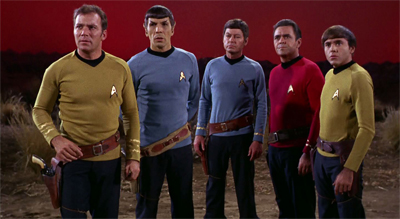
Standoff.
In a way, the gunfight in Tombstone came to represent a defining moment in American popular history. It was a delineation. Historian Jeff Guinn titled his history of the confrontation as The Last Gunfight, arguing that the Gunfight at the O.K. Corral marked the end of the “Old West”:
By 1881 the nature of the frontier was changing. The advantages and restrictions of law and culture were gradually eliminating previously wide-open expressions of personal freedom. Tombstone businessmen wanted a civilized, sophisticated reputation for their town so East and West coast businessmen would be willing to invest locally. That meant pressuring lawmen like Virgil Earp to crack down on Cowboy rustling and carousing. The Cowboys and their cohorts were offended by anyone telling them what they could and couldn’t do. The times were changing, and one key element—the Cowboys—refused to change. That guaranteed that some time, somewhere, there would be the kind of confrontation that had to result in violence and probably death. It happened to occur on October 26, 1881.
Spectre of the Gun finds Kirk standing at the end of Star Trek examining the end of the Old West that had inspired so much of the aesthetic of the show. The end of Star Trek and the end of the Old West, all wrapped up in one story.
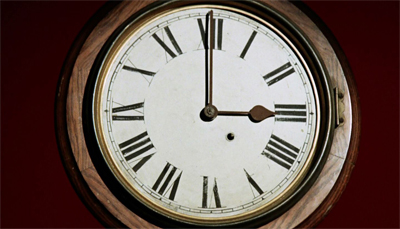
Talk about a deadline.
Indeed, Spectre of the Gun is couched in elements of the Tombstone mythology even outside of its plot. Spectre of the Gun marks the third time that DeForest Kelley has appeared in a version of the confrontation, following an episode of You Are There and the film Gunfight at the O.K. Corral. Even the title of the film is an allusion to Hour of the Gun, a feature film released the previous year starring James Garner and Jason Robards. It is not a surprise that the Melkotians can conjure up the image from half way across the galaxy; it is a surprise they can’t do better.
Of course, the truth of the matter tends to get lost in translation. The actual gunfight took place nowhere near the O.K. Corral, no matter how catchy that title might sound; it took place in a vacant lot on Freemont Street. The gunfight presented in Gunfight at the O.K. Corral lasted seven minutes and ten seconds; in reality, the gunfight was probably over in about thirty seconds. In Spectre of the Gun, the clock counts down to five o’clock; in reality, the confrontation took place at around three o’clock. Fact mingles with fiction, distorted into legend.

Just the cure.
Spectre of the Gun seems to acknowledge the fact that the details of the gunfight at the O.K. Corral are less well known than the myth itself. This is most obvious in the sequence where Doctor McCoy visits the town dentist in order to procure the necessary ingredients for his knock-out grenade, one of the crew’s last-ditch efforts to avoid bloodshed. McCoy arrives at the dentist unaccompanied, walking right in and eyeing the materials that he might need. He is shocked to find himself coming face-to-face with John Henry “Doc” Holliday.
Of course, anybody with any familiarity with the details of the case will know that “Doc” Holliday was the town dentist, which lends an air of inevitability to McCoy’s encounter with him. However, the scene is structured and framed in such a way as to conceal the character’s identity until the last minute. Holliday is in the chair when McCoy arrives, so the audience pays no heed to him. His face is covered, as if the viewer might recognise Sam Gilman. When Holliday does reveal himself, the episode treats it as a twist reveal to catch the audience off-guard.
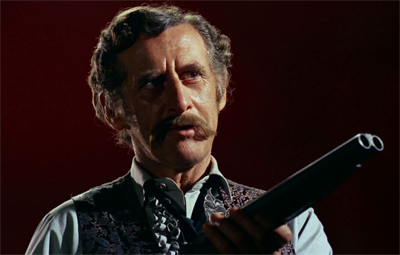
What’s up, Doc?
In Gun Crusaders, Scott Melzer argues that the the whole “gunfighter” myth of the frontier is largely a historical revision that took root in the middle decade of the twentieth century:
Gunfighter skills may be the most celebrated feature of this mythologised frontier gun culture, but they, too, exist as characteristics that were mostly constructed for post-frontier popular culture. In fact, the “gunfighter” Western only appeared in the mid-20th century, when gunplay suddenly became a primary part of the myth of the frontier. The Gunfighter, Gunfight at the O.K. Corral, and The Magnificent Seven helped establish a genre that continued into the 21st century. Gun makers, pulp magazines, and dime novels were important contributors to the romanticising of the gunfighter myth, and the producers of these goods benefited from its widespread acceptance.
Spectre of the Gun seems keenly aware of this fact, meditating on the guns. Kirk and crew find their phasers replaced with pistols and gun holsters.
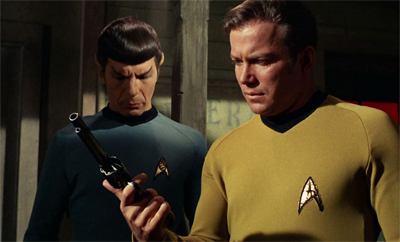
Barrelling toward disaster.
McCoy, who is played by a veteran of two previous iteration of the gunfights, points out that the gun is more real than anything else unfolding around them. “In the midst of what seems so unreal, the harsh reality. This is not a dream.” In a way, this is a grim reflection on the true morality of these western tales. It is the gun that makes reality, that shapes the world. Everything else bends to the application of force. History is written by the victors. In the case of the O.K. Corral, history is written by Wyatt Earp, his account of events vindicated by his gun.
It is telling that Spectre of the Gun chooses to cast Kirk and his crew in the role of the Clantons. They are to be the victims. The Clantons have traditionally been portrayed as the villains of this folklore myth, in reductive accounts that portray Wyatt Earp and Doc Holliday as unequivocal heroes. Spectre of the Gun instead casts Earp and his compatriots as monsters, inviting the audience to feel some measure of sympathy for the Clanton family that had traditionally been portrayed as villainous or fiendish. Clanton’s descendants still felt vilified in 1994.

Not phased in the slightest.
Indeed, as a result of the gunfight, Wyatt Earp was frequently portrayed as an archetypal all-American hero; Earp was a vigilante who bent the frontier to his will. He defined a certain sort of American masculinity. In A Vigilante Life, Andrew C. Isenberg traces this portrayal back to biographer Stuart N. Lake:
In 1931, a biography, Wyatt Earp: Frontier Marshal, by Stuart N. Lake, cast Wyatt as an Old West version of an FBI agent and his Tombstone enemies as an organised-crime ring. Like Eliot Ness or Melvin Purvis, Lake impled, Wyatt rightly resorted to extralegal justice because of the brutality of his enemies and the corruption of local police and judges. During the early years of the Cold War, the icon of the resolute lawman became a symbol of resistance to communism.
In fact, this image of American masculinity still holds sway today, with George W. Bush evoking the promise of “dead or alive” in his pursuit of Osama Bin Laden. With all of that in mind, and against the Cold War backdrop, Spectre of the Gun has a rather pointed political message.
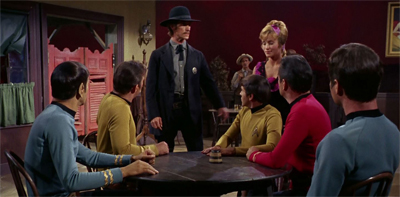
“I didn’t mean to say that the Enterprise should be hauling garbage. I meant to say that it should be hauled away as garbage.”
Spectre of the Gun dares to suggest that there are no winners in this world. At one point, early in the story, Kirk and Spock explain the story to the rest of the crew. “On October 26th, they had it out,” explains Spock, summarising the simmering tensions that soon reached boiling point. “Who won?” Chekov asks. Kirk responds, “The Clantons lost, Mister Chekov.” It is a line that explains the role that Kirk and his crew are to play in this drama, but it also very effectively undercuts Chekov’s question. In this world where might makes right, nobody wins.
During the first half of the episode, Kirk tries repeatedly to find another possible outcome. Kirk tries to leave Tombstone, but he finds himself fenced in. He then turns to Sheriff Behan for protection. Behan openly mocks him. “Since when does a Clanton run crawling to the law for help?” Behan demands. Kirk responds, “How else is he going to get justice?” Behan holds up his gun. “From this.” This is the world in which Kirk finds himself, a world in which moral authority rests on the application of force. Even in this half-imagined world, it cannot be justified.

Forcefielding his hand…
This is very much in keeping with Gene L. Coon’s core themes and ideas. Although Gene Roddenberry would cultivate an image of himself as a pacifist idealist in the years that followed, Roddenberry was fairly politically conservative in his scripting for Star Trek. Roddenberry’s work on episodes like The City on the Edge of Forever, A Private Little War and The Omega Glory all made arguments for justified military intervention against the backdrop of the Vietnam War.
In contrast, Coon seemed genuinely sceptical about any doctrine of moral authority hinging on the application of force. This was most obvious in scripts like A Taste of Armageddon or Errand of Mercy, but it bubbled across his work on the show. Coon was heavily involved in the production of The Trouble with Tribbles, which reduced the Cold War to a joke derailed by cute balls of fluff. Even the end of Metamorphosis suggested that interpersonal connection was far more important and meaningful than the bureaucratic demands of an organisation like Starfleet.
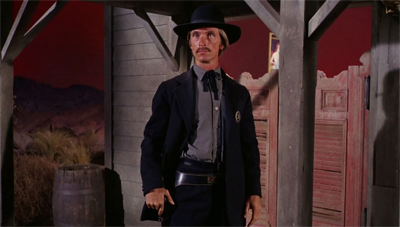
What’s Earpp?
Indeed, Spectre of the Gun revisits some of Coon’s more common themes and ideas. This makes a great deal of sense, given that the episode was produced under a tight deadline due to other obligations. As in A Taste of Armageddon, Kirk finds himself ordered to make contact with an alien species who would really rather be left alone. As in Arena, Kirk finds himself pitted against a monstrous opponent so that humanity might be judged by a far more powerful being.
Arena is something of a major influence here, with Kirk forced into combat and wrestling with his own more violent impulses. At the climax of both Arena and Spectre of the Gun, the enemy finds themselves at the mercy of Captain James Tiberius Kirk. However, this victory is presented as hollow. In both cases, Kirk is exhausted and emotional. In both cases, Kirk declines to murder his opponent. Neither script takes this outcome as a given. Indeed, it would take only the smallest rewrite to justify Kirk’s murder of the Gorn in Arena or the Earps in Spectre of the Gun.
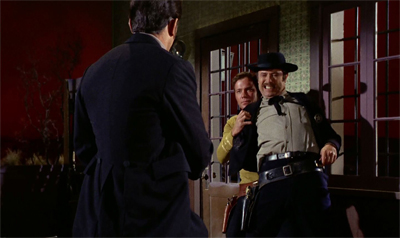
You can’t fight fate.
But you can wrestle with it.
This is very much the point. As written by Gene L. Coon, there is a recurring suggestion that Kirk has a lot of violence inside himself and that he wrestles with that. Kirk repeatedly and consciously tries to deescalate the situation. He intervenes between Morgan Earp and Chekov before things can get too heated. When the threat is made, Kirk reflects, “Well, we’re not going to be at the OK Corral at five o’clock this afternoon.” However, the tension of the episode lies in the fact that there is a part of Kirk that wants to fight.
At the end of the episode, Spock inquires, “This afternoon, you wanted to kill, didn’t you?” McCoy jumps right to the moral, trying to brush over the uncomfortable aspects of the question, insisting, “But he didn’t kill, Mister Spock.” Spock refuses to be deterred. “But he wanted to, Doctor.” The fact that Kirk did not kill Earp is laudable, but it is not the whole story. It is tempting to let Kirk off the hook simply because he proved himself a good man, but Spectre of the Gun is more nuanced than that.
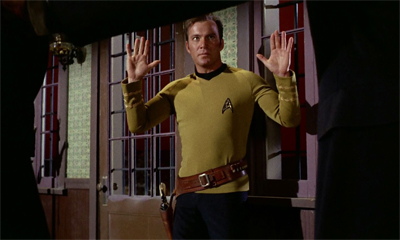
Hands (and heads) high.
“Mister Spock, you’re absolutely right,” Kirk acknowledges. “That’s exactly the way it was.” Spock sums up, “Mankind, ready to kill.” Naturally, this is a bit grim for the obligatory happy ending conversation, so the script steers towards the best possible interpretation. “I wonder how humanity managed to survive,” Spock muses. Kirk offers the happy feel-good conclusion that everybody wants to hear. “We overcame our instinct for violence.” It seems like the perfect place to end an episode.
However, the way that Coon frames this conversation is interesting. Kirk acknowledges that he wanted to kill Earp. He still keenly felt that instinct. When Kirk tells Spock that mankind “overcame [their] instinct for violence”, he is framing it as an ongoing concern. This is not a future where mankind have vanquished all their demons and conquered all their darker impulses. Kirk must constant scrutinised and interrogate his choices. Kirk is a good man, but not through passivity. Kirk makes choices, and those choices are hard.
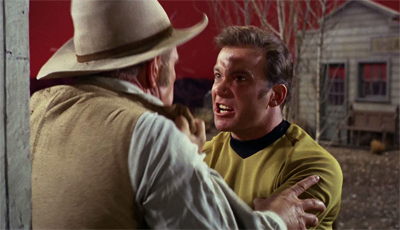
“I! Have had! Enough! Of you!”
This is an interest approach to Kirk as a character, on that stands in contrast to Roddenberry’s idealistic interpretation of the character. As written by Coon, Kirk is constantly questioning himself. As written by Roddenberry, Kirk can seldom entertain a moment of true self-doubt. This contrast perhaps explains the direction in which Roddenberry would take the franchise, embracing the idea that Kirk and the Federation were unequivocal heroes who had no time for second guessing or reflection.
In Spectre of the Gun, Coon ties Kirk’s self-doubt in a larger meditation on Star Trek itself. With its Wild West setting, Spectre of the Gun creates a tangible connection to the franchise’s roots. Star Trek is in many ways a space western, with Kirk defining space as “the final frontier” at the top of every episode. “Wagon Train to the Stars” has become a shorthand for the franchise. This is to say nothing of episodes explicitly couched in the trappings of the Wild West, like the miners and prostitutes of Mudd’s Women or the Native Americans of The Paradise Syndrome.
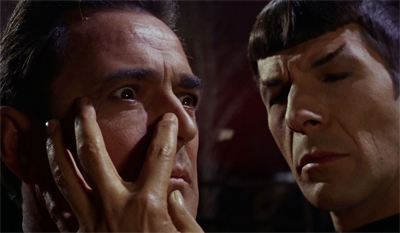
Mind meld over matter.
The script even makes a point to emphasise that Kirk is a literal and spiritual successor to the kinds of characters who inhabit Tombstone. “My ancestors pioneered the American frontier,” Kirk reflects, trying to figure out why the Melkotians picked Tombstone. Spock makes it clear that the choice is deliberately pointed. “The violence of your own heritage is to be the pattern for our execution.” In other words, there is a poetic irony to sentencing Kirk to die as part of a Wild West fantasy, even before positioning that story at the start of the show’s final year.
Spectre of the Gun arrived at a point where the Western was increasingly prone to deconstruction and reinvention. Sergio Leone had shaken the genre to its foundation with his trilogy of so-called “Spaghetti westerns” filmed across Europe. Although the trilogy released in Europe between 1964 and 1966, the three films comprising his “Dollars” trilogy were only released in the United States in 1967. It earned a respectable box office, but also established a template for the future of the Western, one willing to critically examine the genre’s archetypes.
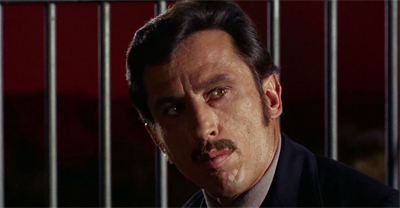
Give him a Wyatt birth.
As Christopher Frayling argues in Spaghetti Westerns, Leone’s films effectively picked apart the assumptions that underpinned so many classic films:
These two strategies – as much as the more explicit criticisms of the ‘myth of the West’ contained within his films – appear to constitute the bases of Leone’s ‘critical cinema’: he exploits the Hollywood Western, at the same time as ‘deconstructing’ it – an act of demythologisation, rather than demythicisation, if one may put it that way.
Of course, Leone would continue this deconstruction in later films like Once Upon a Time in the West and Duck, You Sucker!
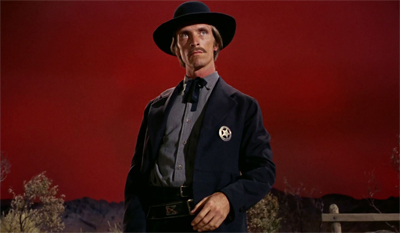
Drawn into a confrontation.
The western myth is one of imperialism and violence. It is the story of European settlers claiming a continent for themselves. Traditionally, the myth has been told in a romantic fashion, the tale of rugged individualists pushing westward and bending the world to their needs. However, this romance tends to gloss over the very real cost of this expansion. The frontier myth is often the story of how might makes right, tied inexorably to the exploitation and subjugation of indigenous populations.
Spectre of the Gun confirms that Kirk is a descendant of the characters who appear in these frontier myths. The comparison is not always flattering. How often has Star Trek presented Kirk and his crew as the champions of a particular set of liberal values, which they liberally impose upon a “primitive” society? What are the Klingons but an extrapolation of the antagonistic “savages” who frequently opposed the settlers, albeit recast for the twentieth century as Asian rather than Native American?
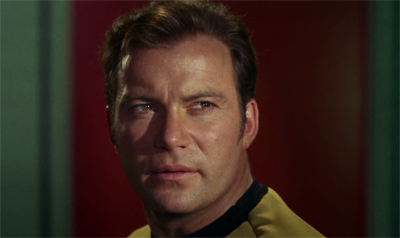
Kirk of fate.
In early drafts of Spectre of the Gun, the Melkotians were known as the Shawnians. Given the themes of the episode, it seems unlikely to have been a coincidence that the name evokes the Shawnee, a migratory Native American tribe who primarily resided in the Ohio Valley. Spectre of the Gun is an episode heavily couched in Western imagery, but it is completely devoid any hint of Native American culture or influence. In some respects, this makes a great deal of sense; the gunfight at the O.K. Corral was an affair for the descendants of European settlers.
However, while this particular Western myth have little to do with Native American culture, Spectre of the Gun is making bigger thematic connections between the Old West and the final frontier. In Spectre of the Gun, Kirk finds himself assigned to make contact with the Melkotians no matter what the cost. Had the episode kept the name “Shawnians”, it might have further underscored the uncomfortable parallels and occasional imperialist subtext that can simmer in the background of Star Trek.

“Don’t worry. You’ll meet some space!Native Americans soon enough.”
Is it any wonder that the Melkotians would be reluctant to make contact with mankind, given these glimpses into their history and character? More than that, Spectre of the Gun emphasises the occasionally imperialist subtext of Kirk’s mission by stressing his refusal to simply let the Melkotians remain undisturbed. The Melkotians signaled their lack of interest in first contact, but Kirk and the Enterprise pressed ahead because they assumed that they knew better. Starfleet’s desire for contact trumped the Melkotian desire for privacy. The Federation must expand.
As such, the western is a problematic template for Star Trek. In many ways, Star Trek is presented as an extrapolation of liberal American values into the future, an idealised extrapolation of Kennedy’s “new frontier” into a future subsequently defined as the twenty-third century. In most cases, the franchise presents an optimistic and open-minded look at what the future might be like, built on tolerance and understanding. However, there are occasional missteps; ill-judged episodes like The Apple or Elaan of Troyius.

Does not scan.
It could be argued that the frontier myth is in some way America’s “original sin.” Producer David Milch described it as such, explaining in Stories of the Black Hills why he had chosen to make the western television series Deadwood in response to 9/11:
I think the human heart yearns to be lifted up … but it’s disingenuous not to recognize that certain moments in history make it hard to acknowledge all our familial connections. It was for something like that reason, in the aftermath of the events of September 11, I didn’t want to do a story with a contemporary setting. I settled on a story about Deadwood because the camp came together in the mid-1870s, deep into the Industrial Revolution, and yet it was a reenactment of the story of the founding of America, and a reenactment, too, of the story of Original Sin.
There is a sense that the violence of the Old West leaves a mark on the American popular consciousness. The myth of the gunslinger is certainly increasingly uncomfortable in a world where gun violence has become an everyday occurrence.

Clouding the matter.
In many ways, Spectre of the Gun finds Gene L. Coon interrogating what it means for Star Trek to be a “space western”, demonstrating that Kirk has to be better than those outlaws of myth. As with episodes like Mirror, Mirror or Bread and Circuses, there is a cautionary element to this story. It certainly seems like the Old West left a mark on Kirk. It seems appropriate for Kirk to take a journey back to the genre that had been such a formative influence on Star Trek. He finds his end in his beginning.
Still, there is hope. Spectre of the Gun is fascinating in the way that it allows Kirk and his crew to escape from this grim pseudo-historical fantasy. Chekov is “killed” approximately half-way through the episode, in a sequence that serves a number of dramatic purposes. Most obviously, it demonstrates the stakes of this drama. Chekov is too important to actually stay dead, but the scene is still effective because it arrives out of left field. It also demonstrates to both Spock and the audience that the narrative can be changed.

And death rode with him.
Inevitably, at the end of the episode, Kirk discovers that Chekov is alive. It is interesting to note how Chekov survived. The default assumption would be that the Melkotians simply revived him or declined to kill him until the simulation played out, returning him alive when Kirk passed the test. However, that is not what Kirk speculates to have occurred. Kirk suggests that Chekov survived being shot by Morgan Earp because he instinctively and idealistically rejected the violence of the world in which he found himself.
“Perhaps that explains why he’s here,” Kirk reflects. “Nothing was real to him except the girl.” In short, it seems like Chekov chose love over violence. In some ways, it is a rather cheesy plot beat, but it does serve an important function. As much as Kirk has to fight to overcome his impulses, it is possible for character like Chekov to survive all of this madness simply through love. It does not matter that the object of Chekov’s affections is not real herself; Spectre of the Gun seems to suggest that the love itself could be real.
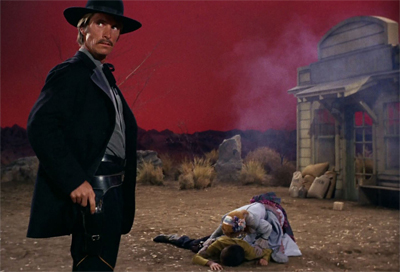
The quick and the dead. But which is which?
Indeed, the sequence before Chekov’s murder is strangely charming, as Chekov tries to explain to Sylvia that he is not the man he appears to be. “It is absolutely impossible,” he explains when she proposes marriage. “I am not someone you can marry. If only I could make clear to you what I really am.” Sylvia responds, “Do you think I don’t know?” There is an intriguing performative aspect to Spectre of the Gun, as emphasised by the half-finished nature of the sets.
Chekov is really just playing a role in this drama, a role that cannot possibly encapsulate everything that makes him unique and which cannot accurately reflect him as a person. In the stagey surroundings of Tombstone, this invites the audience to speculate how much of the “real” world is performative. How many violent young men are simply playing the role that society or culture has mapped out for them? In a world that treats Wyatt Earp as the epitome of a certain kind of masculinity, how can young men like Chekov ever demonstrate what he really is?
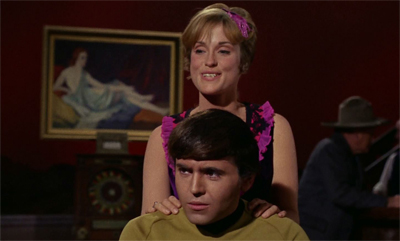
Chekov checks out…
Specte of the Gun places an interesting emphasis on Chekov. Chekov was a character very much intended to speak to younger members of the audience. Indeed, the character’s creation was rooted in Roddenberry’s trend chasing:
Keeping our teenage audience in mind, also keeping aware of current trends, let’s watch for a young, irreverent, English-accent “Beatle” type to try on the show, possibly with an eye to him reoccurring. Like the smallish fellow who looks to be a hit on The Monkees. Personally, I find this type spirited and refreshing and I think our episode could use that kind of “lift.” Let’s discuss.
Chekov very much speaks to a certain for of idealised youth in Spectre of the Gun. Chekov is idealistic enough that his love for an imaginary woman he just met allows him to survive being shot at point blank range.
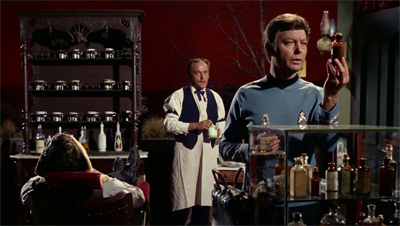
“Yep. That’s the stuff, right there.”
Star Trek often had a troubled relationship with youth culture and counterculture. Indeed, the show often seemed quite wary and skeptical of contemporary movements. At best, like in This Side of Paradise or The Way to Eden, these young idealists were portrayed as well-intentioned but misguided. At worst, like in Operation — Annihilate! or And the Children Shall Lead, it seemed like the series was desperately worried about the breakdown of the social order at the hands of these counter-cultural elements.
However, there were also points at which Star Trek really spoke to that generation of disenfranchised young viewers. Spock became a counter-culture icon, perhaps owing to the fact that he was a a heady blend of sixties iconography; his elf-like demeanour, his enhanced mind powers, his strained relationship with his father. Indeed, it is worth noting that Spock is the character most sympathetic to the space!hippies in The Way to Eden. Indeed, there is a decidedly sixties counter-culture subtext running through Spectre of the Gun, even beyond its pacifism.

“Remember.”
Most notably, Spectre of the Gun is fascinated by questions of the nature of reality. Spock manages to defeat the Earps by rejecting their reality. “Physical reality is consistent with universal laws,” Spock states. “Where the laws do not operate, there is no reality. All of this is unreal.” However, just because it is unreal does not mean that it is inconsequential. Spock explains, “We judge reality by the response of our senses. Once we are convinced of the reality of a given situation, we abide by its rules. We judged the bullets to be solid, the guns to be real, therefore they can kill.”
That is a very trippy set up, even before the heightened production design is factored into the equation. Spock and the crew manage to survive their confrontation by putting mind over matter. Spock uses his Vulcan mind meld to enlighten the other members of the team, to help them embrace concepts as big and unwieldy as “reality” and “unreality.” There is a subtext of consciousness expansion running beneath the surface of all of this, with Kirk and his crew defeating violence by either embracing love and expanding their minds.

Thank goodness Starfleet don’t do mandatory drug tests.
Not for nothing, the crew’s original plan to defeat the Earps hinges on tranquilisers and McCoy takes a mid-episode trip to the local dentist’s office wherein he encounters Doc Holliday. Spectre of the Gun is an episode that features a sequence of Scotty gleefully inhaling a cloud of tranquiliser cooked up by Doctor McCoy. “Did you inhale the gas, Scotty?” McCoy asks. When Scotty replies “deeply”, McCoy follows up, “You still feel all right?” Scott responds, “I never felt better.”
It is too much to argue that Spectre of the Gun is a wholehearted embrace of countercultural values. However, there is definitely a subtext to the episode, with Kirk and his crew rebelling against a very traditional conservative and violent fable through a cocktail of tranquilisers, consciousness expansion and love. Indeed, it could legitimately by argued that Spectre of the Gun is a far more sympathetic portrayal of that culture than something like The Way to Eden, free of the condescension and cynicism.
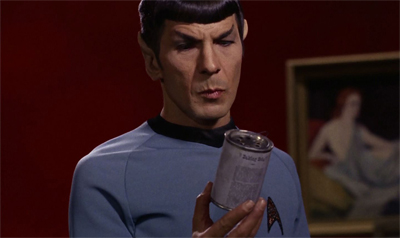
“Mister Scott could not get baked. Curious. This is a tin of baking powder.”
In fact, drugs caused some problems on set. The actor originally cast as Morgan Earp had to be let got after a disastrous first day of shooting. Talking to These Are the Voyages, director Vincent McEveety speculated:
The problem in my opinion was drugs. I had him in a scene with Bill Shatner; all he had to do was take a swing, and he had a couple of lines. Now maybe this was something he’d never done, taking a swing at someone, but I had a stuntman there showing him what to do and when to do it, and he couldn’t even come close at doing that. He couldn’t come up with the lines, either. It’s too bad. I spent a lot of time with him. I had him in my dressing room, where I talked to him, I tried to reassure him that it’s a television show, it’s not the end of the world, let’s just do it, you know. But he couldn’t. He was on another planet.
It is certainly an interesting bit of symmetry to the themes of the story. Either way, Rex Holmann does good work as Morgan Earp, playing the character in a haze, as if not completely there. The characters feel (consciously) as incomplete at their surroundings.
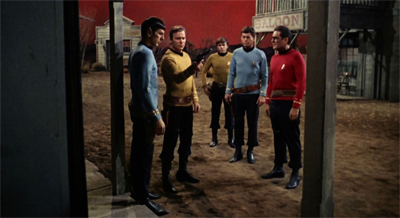
All fired up.
Of course, these threads of consciousness expansion only add to the funereal tone of the episode. By this point in time, sixties counter-culture was just as dead as Star Trek. The summer of love had closed with a funeral marking “the death of the hippie” a year before the broadcast of Spectre of the Gun. Vietnam continued to take its toll on the American psyche, leaving scars that would linger. 1968 was a year of riots and unrest. Richard Nixon was in the process of riding the fears of what he would later term the “silent majority” to the Oval Office.
It could be argued that the sixties ended in 1968. As such, the third season of Star Trek feels like an extended funeral service. The thirds season of Star Trek is shuffling around, a corpse that has yet to notice that its moment has passed and that it is dead. Spectre of the Gun is the perfect episode to launch the production season, just as Spock’s Brain is the perfect episode to launch the broadcast season in its own way. With its ominous red skies and animal skull ornamentation, there is something of the dead about Spectre of the Gun.

Marshalling his forces.
This morbid tone crept into the episode in interesting ways, right down to the performances. Guest star Ron Soble explained his approach to the character of Wyatt Earp in an interview with Starlog:
“‘Play him dead?’ I thought that was really strange direction,” Soble admits. “Actually, though, that simple suggestion turned out to be the key to my performance as Earp. The challenge was to animate this character enough so that he was interesting but at the same time keep him unanimated. I didn’t want to play Earp as a zombie.
“In the scene where I’m on my knees and William Shatner is going to shoot me, I’m using that ‘dead image’ approach.”
The result is a highly stylised episode that embraces the more abstract sensibilities of the original Star Trek. Indeed, many of the strongest episodes of the third season – including The Empath – work in large part because they acknowledge the new production limitations imposed upon the show as strengths.
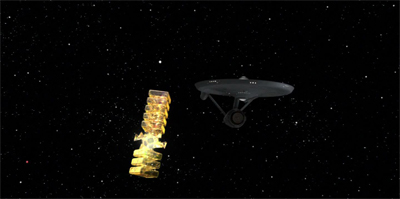
Beacon of hope.
The most memorable aspect of Spectre of the Gun is the production design. Visually speaking, Spectre of the Gun is one of the most distinctive episodes in the entire fifty-year history of the franchise. When the Melkonians conjure Tombstone into existence, it seems half-formed. It looks like a sound stage. Walls are missing. Clocks are suspended in mid-air. The sky is blood red instead of blue or even overcast. It is as though Tombstone has been dislocated in time, part of it moved from Arizona to the uncanny valley.
“It’s just bits and pieces,” McCoy observes. “It’s incomplete.” Given that DeForest Kelley already has a good idea of what Tombstone should look like, it is a pointed line. Spock speculates, “Perhaps the Melkotians have insufficient data about this era.” Kirk responds, “Or perhaps this is all they require to complete the pattern of our death.” The Tombstone presented in Spectre of the Gun is a literal ghost town, an ethereal fragment conjured from our collective imaginations.
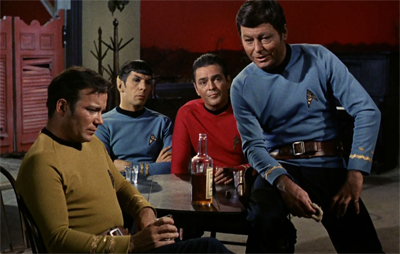
“Wasn’t like this either of the last two times I was here.”
Quoted in The Fifty Year Mission, new producer Fred Freiberger explained that the choice to stage the episode in this way did not come from writer Gene L. Coon:
When Gene Coon wrote the original script for Spectre of the Gun, it took place in an actual western town. Bobby Justman and I thought about how we could help it come, and therefore we did this surrealistic kind of town to try and give it an otherworldly approach. Vincent McEveety was a hell of a creative director. I thought he did some wonderful things with it. I thought the show came out well, and that it was satisfying, considering that was my first episode on Star Trek, though it aired later in the season.
It certainly gives the episode a very unique sensibility. However, the decision to stage the episode in such a way was not merely a creative decision. There were other factors at play.
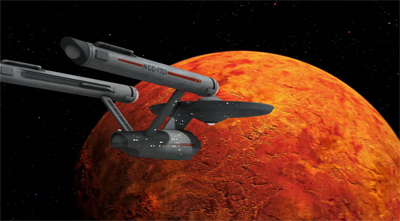
This feels like an appropriate place to mention that Fred Freiberger also produced Beyond Westworld.
On commissioning a third season of Star Trek, NBC dramatically cut the budget of the series. The third season is frequently hamstrung by the limitations imposed by this strict budget. In The Music of Star Trek, producer Robert Justman points to the unique stylistic sensibilities of Spectre of the Gun as designed to compensate for these issues:
I knew we were short on construction money; this was the first show of the third season and we were really trimmed down on budget by the studio, enormously, although our fixed expenses were going up due to casting escalations. We couldn’t afford to go out on location in the third season, that was gone – so we had to figure out how to do a western town on stage and not make it cost too much. … So I had the idea of just using false fronts for the buildings in this so-called western landscape, and I also specified that the colour of the sky be red – an angry red.
The third season of Star Trek could never compete with the first two years in terms of production value. None of the episodes would be able to make as effective use of location shooting as Arena nor work with studio sets as elaborate as The City on the Edge of Forever or A Piece of the Action. The best episodes in the season acknowledged this head-on, rather than trying to hide it. Spectre of the Gun is one such example.
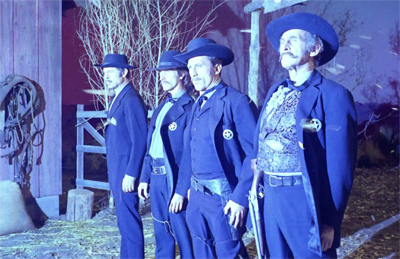
Lightening fast.
It helps that the production team are clearly working within their comfort zone. Spectre of the Gun is the first episode to be produced by Fred Freiberger, taking over production of the third season from John Meredyth Lucas. Freiberger was a veteran of television production, but was best known for his work on Western television shows like Wild Wild West, Iron Horse and A Man Called Shenandoah. He even had two prior writing credits on the television series Tombstone Territory set in the legendary Arizona town.
Director Vincent McEveety had directed five earlier episodes of Star Trek, but a substantial body of his work was tied up in Western television. His directorial credits included Rawhide, Bonanza, Branded, The Road West, and Cimarron Strip. As such, both Freiberger and McEveety demonstrated an understanding of the genre and its trappings. Spectre of the Gun is obviously not a conventional Western, but it hews close enough to make its departures all the more unsettling. It is a credit to the production team.

Hold your holsters.
Indeed, despite the obvious production and budget limitations, there is a very clear sense of scale and drama to the episode. Budget constraints may have dictated (or at least suggested) most of these atmospheric touches like the planet of fog and the half-glimpsed Melkotians or the incomplete sets and the studio-bound red sky, but they serve to make the episode feel distinctive and almost abstract. The fact that none of this is tangible makes it all the more unsettling and disturbing.
This is particularly true at the climax, as the wind rises and there is the sense of a storm brewing in this half-formed world. Despite the limited scope of the episode, it genuinely feels like the end of the world. The Earps are no longer just cowboys or thugs, they are the four horsemen of the apocalypse. They are grim reapers arrived for a bitter harvest. It really feels like the end of the world, which is certainly an appropriate place to open the third season of Star Trek.

The end is nigh.
Of course, it was really the beginning of the the third season. But it was definitely the end times.
Filed under: The Original Series | Tagged: criticism, fred freiberger, Gene L. Coon, postmodernism, spectre of the gun, star trek, westerns |




















I did always wonder why they chose to cast them as the Clantons when the Earps are traditionally the heroes. It is pretty consistent with Star Trek to want to give the other side a fair hearing.
Yep, I think that there’s a lot to Spectre of the Gun that tends to go unnoticed or underexplored because it is on of the franchise’s more goofy premises.
I’ve really been looking forward to your write-ups on Season Three. Glad they’re finally here.
Thanks Ben! Sorry about the decelerated pace!
I always liked it, but as I’ve gotten older I’ve really come to appreciate Spectre even more. I love the stylized cowboy bar room piano music written for it, I love the Kirk Fu in it. Chekov’s got some great character moments. I love Scotty volunteering to test the gas grenade. “Did you inhale the gas deeply, Mr. Scott?”….Aye, deeply, Mr. Spock” Great fun in this one.
Spectre of the Gun is brilliant. It’s wonderfully underrated. In no small part, I suspect, owing to the reputation of the third season as a whole.
This is my favorite third season episode, and one of my all time favorite episodes of the original series. Stellar write-up, as usual. So many things to think about here.
Thanks for the kind words, Sean!
A provocative exploration of the whole concept of reality vs.illusion, and nobody could have explored, speculated on or explained it better than Spock. And the tense, gripping, breathtaking scene of the triple-header mind-meld—actually telepathic hypnosis as only he could do it—was the icing on the cake. As they say on Vulcan: “Vaskurik!” (Beautiful!)—and probably the high point of that otherwise disastrous season.+
Well, a high point certainly. A brilliant absurdist exploration of the myth upon which Star Trek is based.
There is a built in excuse for any historical inaccuracies. They got the scenario from Kirk’s memory and he didn’t have all the details right.
Also, thematically, we are not trapped by our history, but by our beliefs. Kirk’s beliefs were wrong.
(I like these analyses, by the way, even if I don’t read through them very fast.)
Thanks John! Glad you enjoy!
These sort of episodes feel very much like holodeck episodes before there was a holodeck.
Ha! That’s not a bad point, actually.
Rewatching this show (and getting introduced through a rerun of the fifth movie, trial by fire huh), I feel like there’s a direct line between Gene Coon’s version of Kirk, having to be a good person through choices, and the movie arc, where he has to face up to his flaws and everything coming that just little bit harder.
This is fair. Coon is an unsung and under-appreciated hero in the Star Trek pantheon, and I can see his influence straight through to Deep Space Nine and beyond.